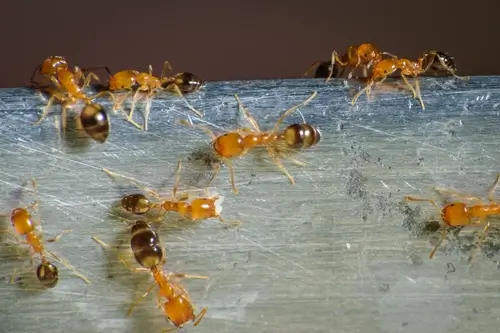

Bug Identifier: Know Your Ants
Ant identification can be tricky: after all, there are around 12,000 species of these insects in the world, and many of them are hard to distinguish from one another thanks to their similar size, shape, and color.
To keep it simple, keep in mind that all ants share a few qualities that help us categorize them:
- Two bent antennae
- Brown black, red, or yellow in color
- Between 1/20 of an inch and ½ of an inch long.
- Body separated by a small pinched area between the thorax and abdomen
Let’s take a closer look at exactly which ants are typically found in North Carolina.
Ant Identification in North Carolina

Acrobat Ants
Acrobat ants can be identified by their heart-shaped abdomen and ability to life that abdomen over their heads—a skill that gives them their name. They are usually yellow, brown, or black in color and around an eighth of an inch long, though the queens are usually larger.

Argentine Ants
When identifying Argentine ants, look for ants that are very small in size—between one-sixteenth and one-fourth of an inch, and glossy dark brown or black. They are also found in very large colonies, which can grow to contain hundreds of thousands of members.

Big Headed Ants
Big headed ants range in color from yellow to dark reddish brown in color. Major ants have large jaws that they use to defend the colony against threats and to cracks large seeds or open other food sources that they find. Minor ants are responsible for feeding the colony, taking care of immature ants, and helping to build the nest. Big headed ants are omnivores and their foraging trails can be seen traveling along the surface of ground, on trees, and along walkways.

Carpenter Ants
If you’ve ever dealt with carpenter ants, you already know that this species earns its name with its affinity for wood. Unlike their namesake, though, these insects are destructive, damaging wood as they create their nests inside of it. If you spot ants with an evenly rounded upper thorax and a one-node waist, and you may have identified carpenter ants.

Fire Ants
While many ants are harmless, fire ants are most commonly associated with their aggression. These dark red and brown pests are usually between one-eighth and three-eighth of an inch long. When threatened, they work together to repeatedly attack the perceived danger, stinging and injecting venom that results in painful bites.

Ghost Ants
Ghost ants are very small, with a dark body and faintly-colored legs, abdomen, and antennae. These are usually found in kitchens and bathrooms when they make their way inside.

Black Ants
A type of sugar ant, little black ants tend to be attracted to food and are often found in kitchens. Identifying these ants is fairly simple when you consider their name: they are small, black, and relatively slow-moving.

Odorous House Ants
Also called a stink ant, you may actually smell an odorous ant before you see it. Odorous ants are either dark brown or black and grow to be only about an eighth of an inch long. You’ll notice that their thorax is bumpy when you get a closer look at them, especially when viewed from the side.

Pavement Ants
Pavement ants can be identified by their location. Just as their name suggests, these ants are typically found in driveway and sidewalk cracks and under foundations. They are small, usually dark brown or black, and have a thorax with a pair of small spines extending out from the rear.

Pharaoh Ants
Pale red of yellowish-brown in color, worker Pharaoh ants have abdomens that are dark in color than the rest of their body. They grow to a tiny 1/16th of an inch in length. Queens are a bit darker and color and are double in the size of the workers- growing up to 1/8th of an inch in length. A unique fact about Pharaoh ants is that they prefer to nest inside structures as opposed to outside.


Ant Facts:
What Is the Most Painful Ant Bite?
There are a few ants that can deliver a surprisingly powerful bite for their size. The most painful by many accounts? The bullet ant bite. These ants are found in the Amazon rainforest, in the area spanning Nicaragua all the way to Paraguay. They are the largest ant species at around an inch in length.
Their bite has been described as one of the most painful of any insect bite, releasing a neurotoxic peptide called poneratoxin into their victim that leads to a neurotoxic peptide that causes severe muscle contractions, a burning sensation, and great pain that can last as long as 24 hours.
While the initial bite is extremely painful and redness, irritation and swelling are common, be on the lookout for signs of allergic reaction – bull ant bites have killed people in the past due to the potency of their venom
Not in NC
How Much Can an Ant Lift?
The amount of weight an ant can lift varies based on the species, but ranges from anywhere between 10 and 50 times their body weight. If that doesn’t sound impressive enough, think about it this way: If a human being weighing around 150 pounds could lift even twenty times their own weight, they would be able to lift a Toyota Corolla.
About How Many Venomous Ants Are There in North Carolina? In the World?
In North Carolina, the only venomous species of ant we have to worry about are the fire ant and carpenter ant. In most cases, these stings and bites will burn and blister, but the pain will subside fairly quickly. Very rare cases of a fire ant triggering life-threatening reactions have occurred, though.
When it comes to exactly how many ants in the world are venomous, the answer is a little complex. While around 71% of ants are stinging and biting species, they don’t all inject venom with their bite.
The most dangerous of these in the world is the bulldog ant of Australia. This aggressive species bites and stings, emitting a venom that is strong enough to kill in about 15 minutes.
How Fast Do Ants Procreate On Average?
Even in a colony of hundreds of thousands of ants, only the queens of the colony can lay eggs. When first mated, a queen lays around a dozen eggs at a time. As the colony grows along with their food sources, that can increase to as many as 800 eggs a day.
How Long Does It Take To Get Rid of an Ant Infestation on Average?
If you’ve noticed an ant infestation in your home, you’ll want to start treatment ASAP. Because ants are so small and quick to procreate, they can be especially difficult to get rid of. With the right tools and approach, an ant infestation can usually be solved in about a week or two.
What to Do if You Have an Ant Infestation
At best, an ant infestation is annoying. At worst, it’s a danger to your home and your health. If you have an ant problem, it’s best to use a combination of addressing both the inside of your home and the perimeter. You can try liquid bait traps, a pesticide (though these can pose risks to people and pets when not used carefully), or natural remedies like peppermint and clove oil.
To save time and money, it is usually best to contact a professional pest-removal service like A-1 Pest Control for large infestations.
Prevention is key to keeping the ants away once the problem is resolved. To reduce the chance of another ant infestation, try:
- Repairing any and all foundation cracks and leaks
- Sealing gaps in doors and windows
- Removing hiding places like leaf piles and firewood
- Eliminating standing water

About A-1 Pest Control
Ant infestations can be overwhelming. Though these insects are small and typically harmless to our physical safety, they can get into food, cause damage to your home’s structure, and ruin your day. If you need help with ant prevention or extermination in North Carolina, the experts at A-1 Pest Control can help.
Contact us today to learn more about our pest control plans to tackle ants—and many other creatures and critters that are best left outside!
Recommended Program For This Pest
Home Shield Plus - Most Popular!

Initial Treatment
Only $
What's Included:
- Year-Round Protection
- Covers 15+ Pests
- Free Re-treatments
- Stinging Insect Control on the Structure
- Seasonal Mosquito Treatments
- 10 Treatments
- Outdoor Tick & Flea Control
- Indoor Flea Treatments
- Fire Ant Control
- Sentricon Termite Protection
Contact Us
Please fill out this form and we will get back to you shortly.
"*" indicates required fields

